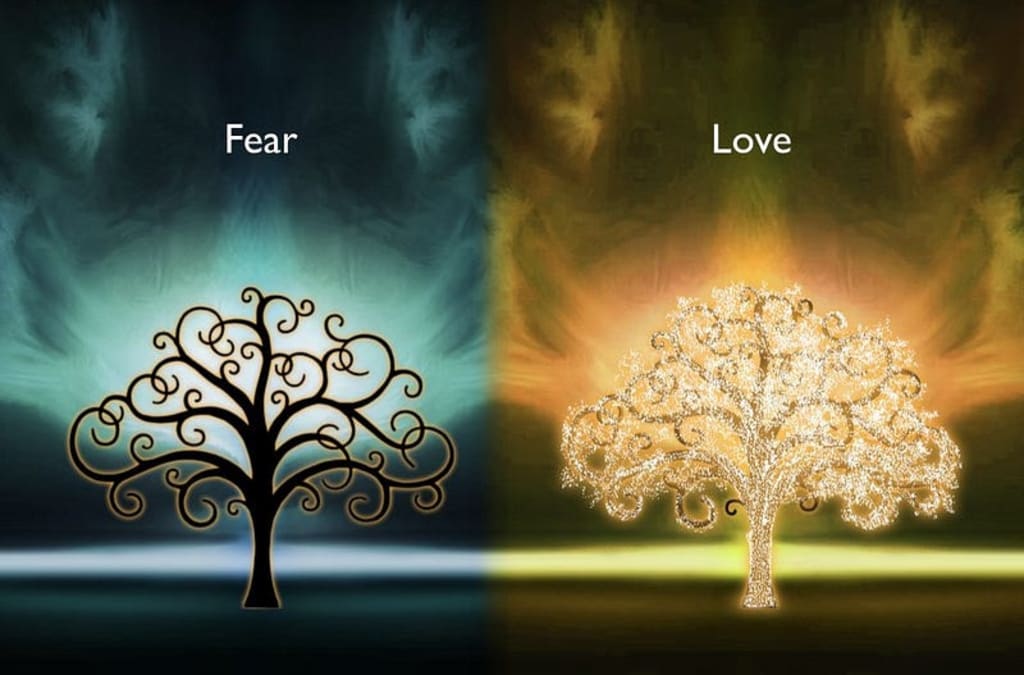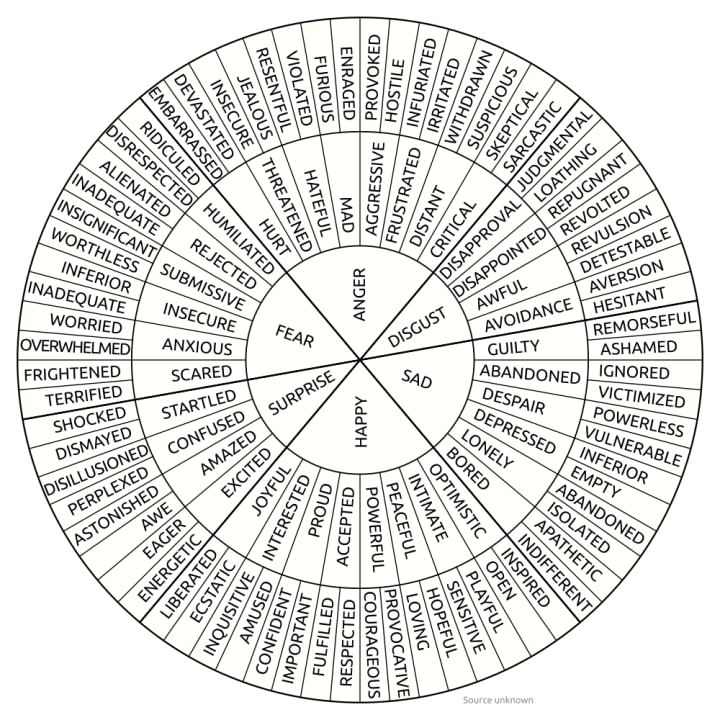Love and Fear: two emotions that drive us
Lovr and Fear

The Emotions -Love and fear. These two emotions have the power to shape our lives in profound ways. Whether we are aware of it or not, these two feelings can dictate how we view ourselves and the world around us. In this blog post, we will explore how love and fear both affect us in our daily lives, and how they impact the decisions we make on a personal, social, and global level. Ultimately, understanding the power of these two emotions can help us to better navigate our lives and make choices that will lead us to a happier and more fulfilling future.
Table of Contents
- What is Love?
- What is Fear?
- How Love and Fear are the Foundation of all the Emotions
- How can we use love to empower ourselves?
- How can we overcome out fears?
- The Emotions Wheel
What is Love?
Love is an emotion that has been around since the dawn of humankind and remains one of the most powerful emotions we experience today. It’s a feeling of deep affection, care, and appreciation for someone or something. It’s a sentiment of fondness, attachment, and deep regard. Love can be directed towards family, friends, strangers, animals, places, memories, objects, and even ourselves.
When it comes to relationships between two people, love is often used to describe the romantic connection between them. This type of love often involves strong emotions of admiration, attraction, and devotion. However, love does not always have to be romantic. It can also be platonic and familial, such as between siblings or parent-child relationships.
Love is a complex emotion that can bring us great joy and peace of mind when we feel it. It is often seen as a powerful antidote to fear and pain, which makes it an important tool in helping us cope with difficult situations.
What is Fear?
Fear is one of the most primal and powerful emotions that drive us. It is an instinctual response to potential danger or threat and can be both rational and irrational in nature. Fear can manifest in a variety of ways, ranging from physical symptoms such as a racing heart rate, sweating palms, and trembling, to psychological symptoms such as feelings of anxiety and dread. Fear is an evolutionary tool that helps protect us from harm by triggering the body’s fight-or-flight response, allowing us to escape dangerous situations.
At its core, fear is a product of our own thinking and beliefs about a situation. It can be rooted in either past experiences or irrational thoughts and worries about the future. Fear can be triggered by external threats such as natural disasters, physical harm, or emotional pain, as well as internal threats such as self-doubt, failure, and rejection. The intensity of fear can also vary from person to person depending on how much emotional weight we assign to a particular situation.
In order to manage our fears, it is important to identify the root cause of them and learn how to effectively cope with the feelings they evoke. This can be done through a variety of methods such as cognitive behavioral therapy, mindfulness practices, and lifestyle changes. While fear can often seem overwhelming and out of our control, it is possible to take back the power by understanding and challenging the underlying beliefs that are causing it.
How Love and Fear are the Foundation of all the Emotions
Love and fear are two of the most powerful emotions that drive our decisions and behavior. They can both be positive or negative influences in our lives, depending on how we use them. Love is a feeling of deep affection, care, and connection. It can bring us joy, fulfillment, and a sense of security. Fear, on the other hand, is an emotion that is usually associated with danger and the unknown. It can make us feel anxious, overwhelmed, and helpless.
Though these two emotions may appear to be opposites, they are actually intertwined and have a symbiotic relationship. Fear can lead to feelings of love when we overcome it; while love can result in fear when we are afraid of losing something or someone we care deeply about. Both love and fear serve a purpose in our lives; they act as warning systems and motivators to help us make decisions that are best for us.
Fear has the power to make us take action when necessary, such as running away from danger or facing our biggest fears. It can also be a source of motivation when we need an extra push. Love can also be a source of motivation, giving us the strength to try something new or work hard to achieve our goals. It can also give us courage to pursue things that scare us.
In addition, fear and love can both lead to further emotions such as anger, anxiety, or sadness. Fear can cause us to become angry and defensive when we are in a situation where we feel threatened or scared. Similarly, love can make us sad or anxious when we worry about losing the people or things we care about.
Overall, love and fear are fundamental emotions that are the building blocks of all other emotions. They help us make decisions, motivate us to take action, and guide us through life’s many challenges. By learning how to manage these two emotions in healthy ways, we can create a healthier and happier life for ourselves.
How can we use love to empower ourselves?
Love is one of the most powerful forces in the world, and it can be a great tool to help us reach our goals and become better versions of ourselves. When we use love to empower ourselves, we are tapping into a source of power and motivation that can help us move mountains.
The first step in using love to empower ourselves is to start by loving ourselves. This may seem difficult at first, but it is essential if we want to use love to motivate ourselves. By accepting and embracing ourselves, we create a foundation of self-love that will fuel our motivation. When we are able to feel the love for ourselves, it gives us the strength and courage to pursue our goals and take risks.
Once we have established a strong foundation of self-love, we can use love to motivate ourselves in other areas as well. When we love our family, friends, and communities, it gives us an even greater sense of purpose and drive. We feel more connected to the people around us, and this helps to strengthen our bond with them. We also start to view failure as an opportunity to learn and grow, which encourages us to keep pushing forward no matter what.
Finally, using love to empower ourselves also involves showing compassion to those around us. We can use love to lift up those who are struggling and show them kindness and understanding. This not only helps us build stronger relationships with others, but it also helps us develop a deeper appreciation for life and all of its challenges.
Love is a powerful force that can be used to empower ourselves and help us reach our goals. By establishing a strong foundation of self-love and showing compassion to others, we can tap into a source of motivation that will propel us forward in life.
How can we overcome out fears?
Overcoming our fears can be a difficult task, but it is a worthwhile endeavor. It requires us to confront our fears and take ownership of them. Here are some tips to help you in overcoming your fears:
1.Acknowledge your fear: The first step in overcoming any fear is to acknowledge its existence. Many times, we may have difficulty recognizing that we are afraid because we don’t want to confront the emotion head on. Recognizing your fear is the first step towards overcoming it.
2.Identify the source of your fear: Once you recognize that you have a fear, it’s important to identify the source. This could be a particular event or situation or even a person or relationship. Understanding the source of your fear can help you better understand why you are afraid and how you can work through it.
3.Educate yourself: Education can go a long way in helping you to overcome your fear. Researching the topic and learning about it can help you gain perspective and make the fear seem less daunting. This can help you take away some of the power your fear holds over you.
4.Create an action plan: Once you’ve identified the source of your fear and done some research, it’s time to create an action plan. Write down what steps you need to take to face and conquer your fear. Break this plan down into manageable chunks and focus on tackling each step one at a time.
5.Practice self-compassion: Be kind to yourself while working to overcome your fear. If at any point you feel overwhelmed or like you’re not making progress, remind yourself that these feelings are normal and try to practice self-care.
6.Find support: Seek out friends, family members, or professional help if needed. Having support from others can make all the difference as you work towards conquering your fear.
Working through our fears can be a challenging process, but with patience and determination, we can overcome them and come out stronger on the other side.
The Emotions Wheel

The emotion wheel is a tool used to help recognize and express the range of emotions we experience. It’s divided into six primary emotions – anger, disgust, sad, happy, surprise, fear – and several secondary emotions, including amusement, awe, embarrassment, envy, guilt, pride, relief, and interest. The idea is that these primary and secondary emotions can be represented in a circle so that we can easily identify which feelings we’re having and how they interact with each other.
For example, when we’re feeling joy, it may also be accompanied by feelings of anticipation or excitement. When we’re feeling sad, it could be paired with feelings of guilt or embarrassment. By recognizing the different combinations of emotions that we experience, we can better understand ourselves and our behavior.
Using the emotion wheel is a great way to become more aware of our emotional state. It can help us recognize why we may feel a certain way and develop healthier ways to cope with difficult emotions. It can also help us cultivate empathy and better understand how others might be feeling in certain situations. Ultimately, the emotion wheel serves as a useful tool for understanding and expressing our emotions.
Click here to learn more about the the other emotions.
Click here to learn more about the lucid dreaming
About the Creator
Enjoyed the story? Support the Creator.
Subscribe for free to receive all their stories in your feed. You could also pledge your support or give them a one-off tip, letting them know you appreciate their work.





Comments
There are no comments for this story
Be the first to respond and start the conversation.